AP PSYCH Part 2
1/80
There's no tags or description
Looks like no tags are added yet.
Name | Mastery | Learn | Test | Matching | Spaced |
|---|
No study sessions yet.
81 Terms
Concept
mental groupings based on shared features that come from experience
Ex: fruit
come in 3-level concept hierarchies
superordinate: broad→fruit
intermediate: basic→apple (most children learn first)
subordinate: specific→granny smith
help simplify the world, allow us to organize, generalize & associate experience, objects and situations
play a role in language, memory and learning, when we see something new we try to relate it to previous concepts
2 main categories
concrete: formal concepts
defined by set of rules or characteristics
natural: abstract concepts
imprecise, develop out of everyday experiences
Prototype
the ideal example of a concept
generic image that represents a typical example from your experience
Ex: animal→dog
we tend to make judgements based on our prototype
Which measure of central tendency would be used to represent the most common response for a group of participants
mean: numerical data, normal distribution
median: numerical data, skewed/outliers
mode: categorical (nominal data)
Ex: names, colors, brands, (non-numerical, looking for frequency)
what appears most frequently in a data set
range: numerical data, spread of data/variability
difference between highest & lowest values
shows how diverse/consistent a data set is
Schemas
building blocks of intellectual development/mental frameworks that make organization and meaningful action possible
clusters of related concepts that provide generalizations/categorizations of things
develop from our experiences and act as a filter as we encode new information
schemas are helpful and provide context
identify social roles in certain contexts
provide quick generalizations→stereotypes
organize past experiences→help us understand and interact with future situations (provide a framework)
People form and modify schemas through
Assimilation (happens first)
taking in new information but not changing the schema
placing new information into an existing schema
past experiences→teach us how to respond to new experiences
Accommodation
taking in new information and changing the schema to incorporate the new information
changing an existing schema or creating a new schema
Algorithm vs. Heuristic
Algorithm
address problems by attempting all possible solutions until the correct one is found
pro: if followed correctly→accurate solution
con: can’t solve problems that require subjective values/have too many unknowns & time consuming
in questions look for guaranteed methods
Heuristic
address problems by using mental shortcuts to make judgments
pro: fast & efficicent, simplify problem solving
con: do not guarantee a solution, are more error-prone than algorithms
Ex: decide who is oldest child by looking for the tallest
In questions look for educated guesses/judgments
Types of heuristics
representative heuristic
can lead to errors in judgment when decisions are made according to prior expectations or stereotypes
matches a prototype
availability heuristic
can lead to errors in judgment when decisions are made by recalling the first or most vivid example that comes of mind
based on how quickly it comes to mind
Ex: who does more chores, you or your sibling→you do dishes
Influences on Decision making
Decision making can be influenced by prior experiences that were successful (mental set) or by circumstances surrounding a decision (framing)
mental set: approach new problems the same way that worked before
expertise backfires
framing: way the issue is presented/worded or structured
people react to how something is phrased rather than what is said
ex: 90% survival rate, vs 10% death rate
What hinders decision making
Gambler’s fallacy: false belief that you can predict a chance event based on past chance events
Sunk-cost fallacy: a bad decision based on money, time, or effort that has already been spent
Executive Functions
cognitive processes that allow individuals to generate, organize, plan and carry out goal-directed behaviors and critical thinking
self regulation: delaying gratification to motivate
linked to prefrontal cortex
Creativity
way of thinking that includes generating novel ideas
making new & original ideas that are useful
alternative uses test: list as many possible uses for a common object
(# of alternatives, how unique/across categories, detailed)
creativity may be enhanced with expertise, imagination, a venturesome personality, intrinsic motivation & a creative environment
Research Methods and Design
Experiment: manipulate independent variable (ex: environment) and random assignment of participants to control & experimental groups to measure differences in the dependent variable (ex: creativity)
Non experimental methodologies
Case Study: in-depth analysis of previous case
ex: surveys & naturalistic observation of a famous creative person
Correlation: study investigating the strength & direction of the relationship between creativity & personality characteristics
Meta-analysis: statistical method that combines results of several specific creativity studies
Divergent vs. Convergent thinking
Divergent thinking
generating/considering many different ideas/solutions to a problem
thinking breaks off in different directions
Convergent thinking
using logic/knowledge to narrow down options to find the known solution or a single correct answer
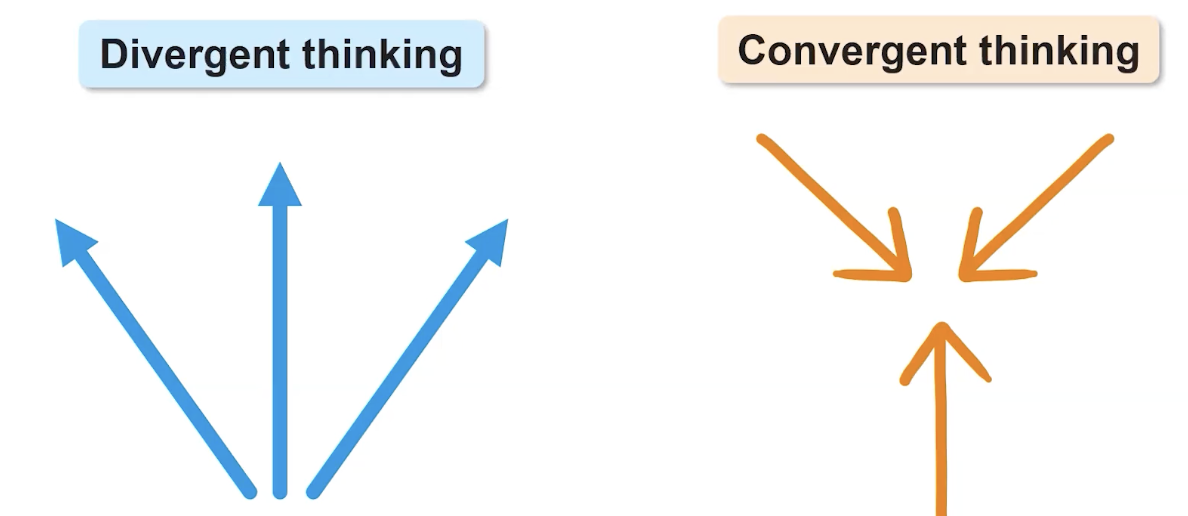
Functional Fixedness
failing to solve a problem because you are stuck on the object’s common use
creative thinking is hindered by functional fixedness
Different types of memories
Explicit Memories (declarative memories)
Memories we recall with conscious awareness
Episodic
memories specific to our unique personal experiences
something you can tell me all about
Semantic
information we know, specific facts/conceptual understandings
know something requires something else
Prospective
remembering to remember; memory of an intent to perform a specific action
ex: recall details of memory (birthday party)
knowing the need to do something
Stored all over the brain, storage requires hippocampus
Implicit Memories (non-declarative memories)
Memories we recall without conscious awareness
Procedural
knowing how to do something
Classically conditioned responses
learned associations that evoke emotion/physiological responses
Primed responses
exposure to one thing unconsciously influences future thoughts or behaviors
ex: explain how to walk up stairs
given many examples of one thing (bread, juice milk) you associate the next word so_p with soup
Multistore Memory Model: Baddeley & Hitch
Revised to refer to “short term memory” as “working memory”
working memory contains a limited amount of info that can be temporarily maintained & used for many cognitive tasks
C.T.: remembering, solving, imagining, learning
Working Memory Model
Central Executive Boss
does planning & decision making
directs components of cognitive tasks to the visuo-spatial sketchpad and auditory loop
prefrontal cortex
Phonological Loop
information comes in as a verbal input
information you’re manipulating in your head/saying to yourself over and over again
broca’s area
Visuo-Spatial Sketchpad
information comes in as visual input
maintain a visual memory of it & associating relationships with other visual memories
parietal lobe (spatial perception)
occipital lobe (visual cortex)
Long Term Memory works with these (integrates with working memory) to address the cognitive task/solve the problem
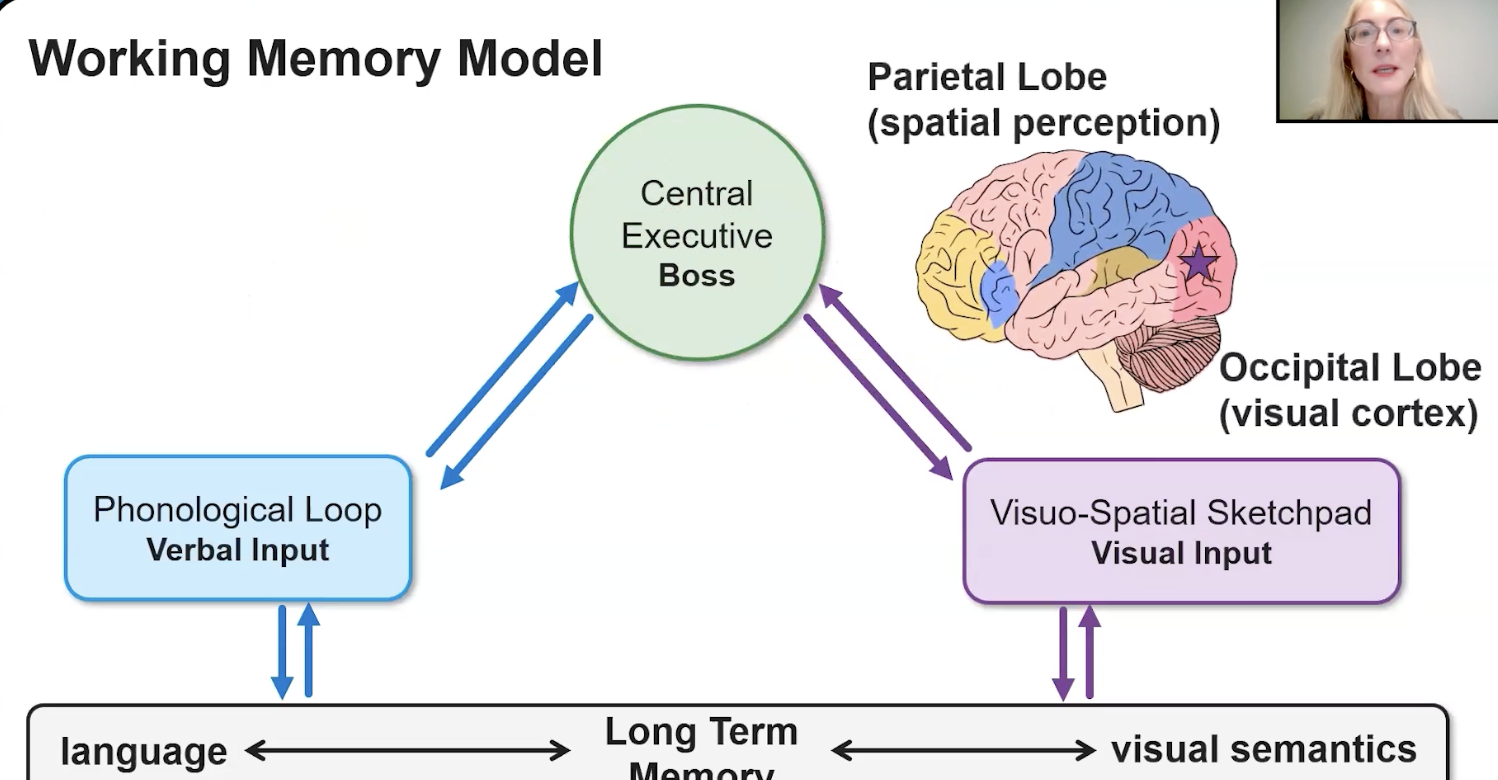
Multistore Memory Model
Memory consists of three stores: sensory, short term, long term
Sensory memory briefly stores whatever is coming in through hour auditory/visual senses
If we pay attention to what is in our sensory memory, it will be transferred to short-term memory & stored, without rehearsal, for about 15-30 seconds
From there, we can encode it into our long-term memory, perhaps using effortful processing to increase our chances of retrieving it later
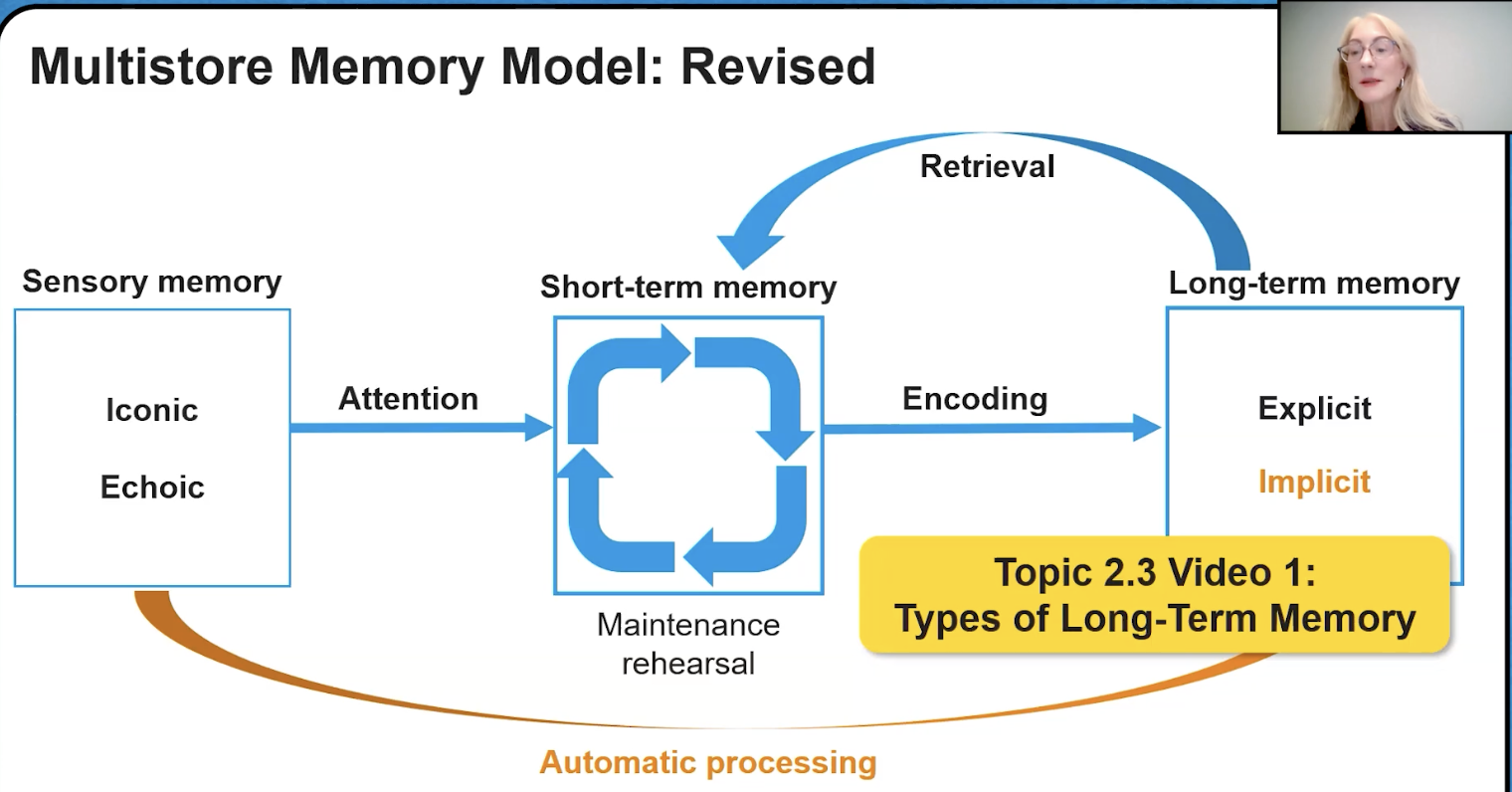
Sensory Memory
Iconic Memory (“eye”-conic)
brief memory for visual inputs-decays quickly
Echoic Memory (“echo”/sound)
brief memory for auditory inputs-decays quickly, but not as quickly as iconic memory
If we pay attention to anything in our sensory memory, it transfers to our short term memory
Short Term Memory
Temporary storage of information we attend to from our sensory memory
Capacity: Magic number 7 (plus or minus 2)→5,9
Duration: 15-30 seconds
If we repeat the information we can keep it for a while, and might have a chance of encoding it into our long term memory
Long Term Memory
Can be retrieved back to short term memory to work with later on
Levels of Processing Model of Memory
Craik & Lockhart propose that memory recall is a function of depth of processing
Encoding
how you encode information will directly affect your ability to later retrieve it
The 3 levels of processing:
Structural processing (shallow)
shallow processing leads to a less long-lasting memory
Phonemic
Semantic (deep)
deep processing leads to a longer-lasting memory
Shallow Processing: Structural
Encoding using basic visual qualities of the word/concept (physical features)
ex: the word has 5 letters
Shallowest level of processing
Phonemic Processing
encoding using the basic auditory (sound) qualities the word/concept
ex: baker rhymes with shaker
shallow level of processing
Semantic Processing
Encoding the meaning of the word
ex: relate to personal experiences, existing semantic memories
Deep level of processing
Shallow vs. Deep Processing
Shallow Processing
Structural & Phonemic
Focus on physical features
Maintenance rehearsal
Stays in short term memory for longer
Less durable/long-lasting long term memory
Deep Processing
Semantic
build meaning (semanticity)
Effortful processing
long term effort
Encodes into long term memory
more durable long term memory
DRY MIX
Dependent-Reaction-Y-axis
Measured-Independent-X-axis
Experimental vs. Control group
Experimental group is exposed to independent variable
Control group is exposed to “placebo” or no treatment at all
Population vs. Sample
Sample: random selection of sample from the population
can be used to generalize for the whole population
must be random assignment (even when assigning control/experimental groups)
Ethical Guidelines
must be followed
approval for research is usually done by an Institutional Review Board
Mnemonic Devices
Used to encode information in a way that aids in retrieval by connecting new information to something familiar
Method of Loci
A mnemonic device that relies on spatial relationships between loci (ex: locations on familiar route/rooms in a familiar building) to encode & later retrieve info
Correlational Studies
unlike experimental, cause and effect cannot be inferred (only experiment can have “cause & effect”)
observe relationship btwn. variables without manipulation
variables are not controlled
random assignment to conditions is not utilized
Hemispheric Specialization
Language (for most) is a task represented by the left hemisphere
Self Reference Effect
relate each word to yourself personally
leads to better retention than shallower levels of processing
How the 3 measures of central tendency vary btwn. normal distributions and skewed distributions
mean leans to right or left
outlier
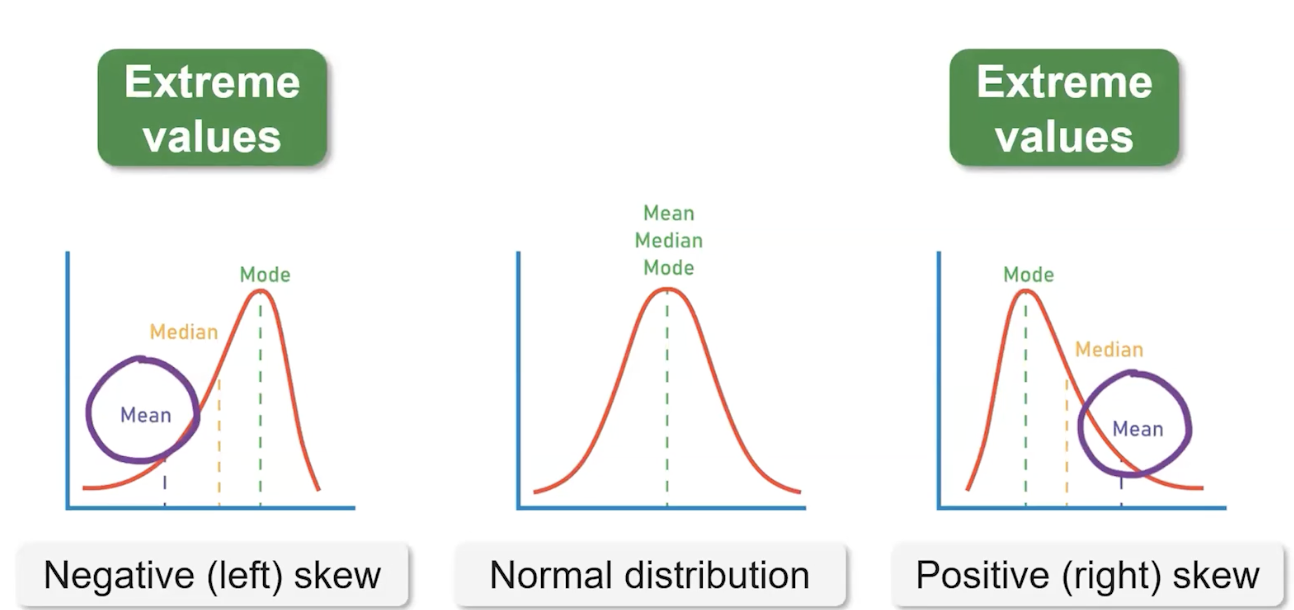
Capacity & Duration Comparison Memory Model
Sensory
Fleeting storage of information that we receive from our senses
Capacity: unlimited
Duration:
Iconic <1 second
Echoic: <4 second
Studies: Sperling’s partial report
“whole report” could only list 4-5 letters
“partial report” given a tone, could accurately report all letters from cued row
indicates iconic memory held all letters, but it’s fleeting
Short Term/Working
Temporarily heightened availability of information about a small number of recent events and thoughts
Capacity:
7±2 digits
6 letters
5 words
Duration
<12 seconds without rehearsal
Studies
Digit Span Tests
~50% participants could correctly recall 7 digits (around 5-9)
Long-Term
Includes both explicit and implicit memories
Capacity: Unlimited
Duration: Stable across lifetime
Studies: Ebbinghaus’s forgetting curve (decay memory)
nonsense syllables (prevent encoding/tying to already know), tested different time intervals
very rapid loss or recall in 1st hour, followed by slightly slower loss
after 24 hrs, only 1/3rd is stored relatively permanently
Fleeting Iconic Memory: Change Blindness
Change blindness: our inability to detect small visual changes in our environment
Iconic Memory: lasts less than a second but holds a lot of info in that time
By the time we are asked to recall, our iconic memory likely has faded
Ebbinhaus’s Digit Study
Correlational Study
tested himself, not randomized participants
no control groups/gereralizability
just observed how memory behaved
Ebbinghaus’s Forgetting Curve
Independent Variable: # of digits presented
Dependent Variable: Success rate of recall
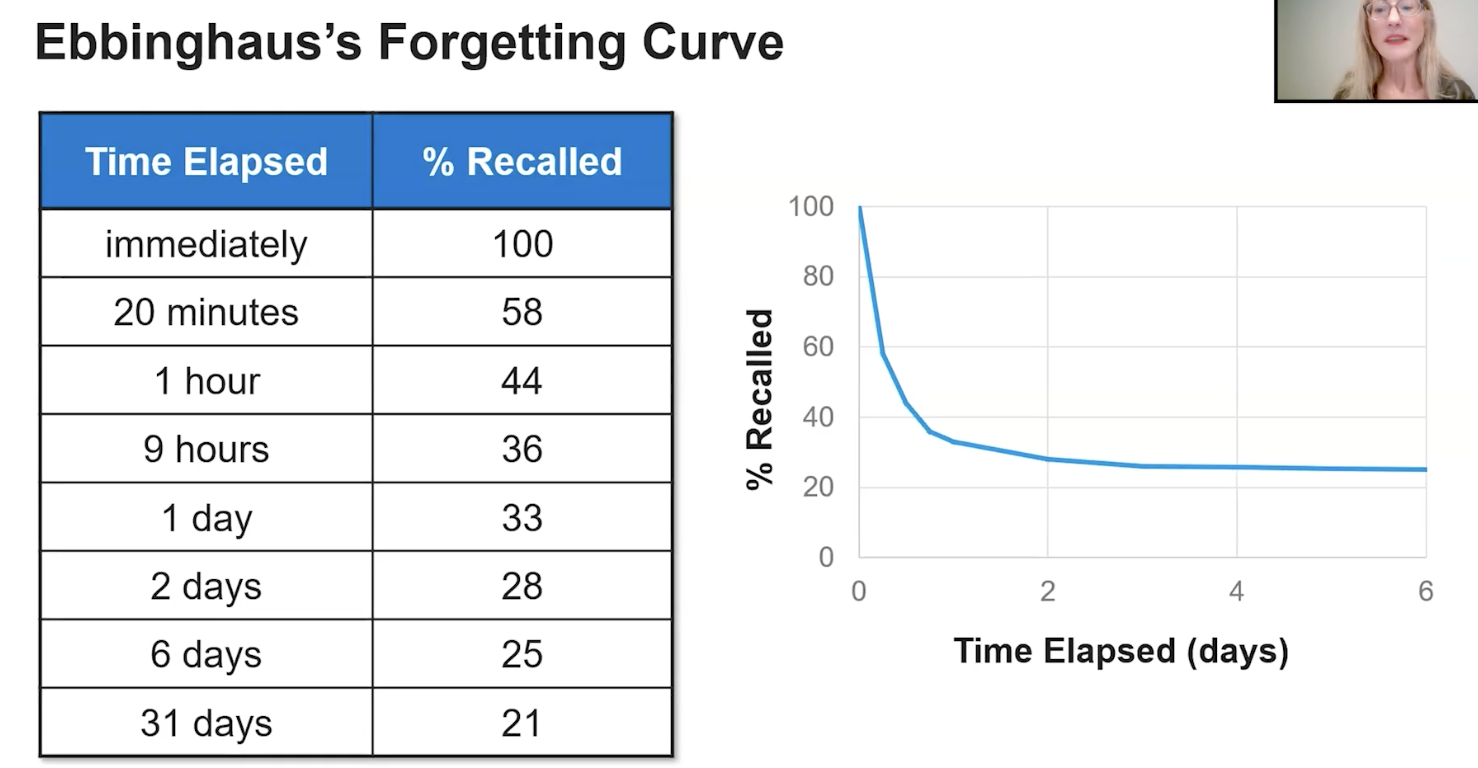
Explicit Memories: Where are they stored?
Karl Lashley Rat Experiment
rats learn maze then destroyed different regions of their cerebral cortex
most rats had a memory of a part of the maze
Study shows: memories are distributed throughout the cortex
Explicit Memories: What are the biological processes to form these memories?
Case Study
unusual cases that presented themselves
Henry Molaison Study
Removal of portions of the hippocampus in the limbic system prevented new memory formation
implicit memories were not affected
Patient R.B. (died 1986)
after stroke couldn’t form new memories
no other cognitive impairment
autopsy showed damage to hippocampus
Shows: Areas of the hippocampus are essential for new explicit memory formation
Anterograde Amnesia (can’t form future)
Hippocampus Damage
Inability to form new memories
Problem moving information from short term into long term memory
Case studies: R.B. & Henry Molaison
Retrograde Amnesia (retro→can’t remember past)
Damage to some part of the cortex
Inability to recall old memories
Problem: retrieving explicit memories from long term to working memory
Experiment: Lashley’s experiment with rats
Global Amnesia
Having both Retrograde (past) & Anterograde (future) Amnesia
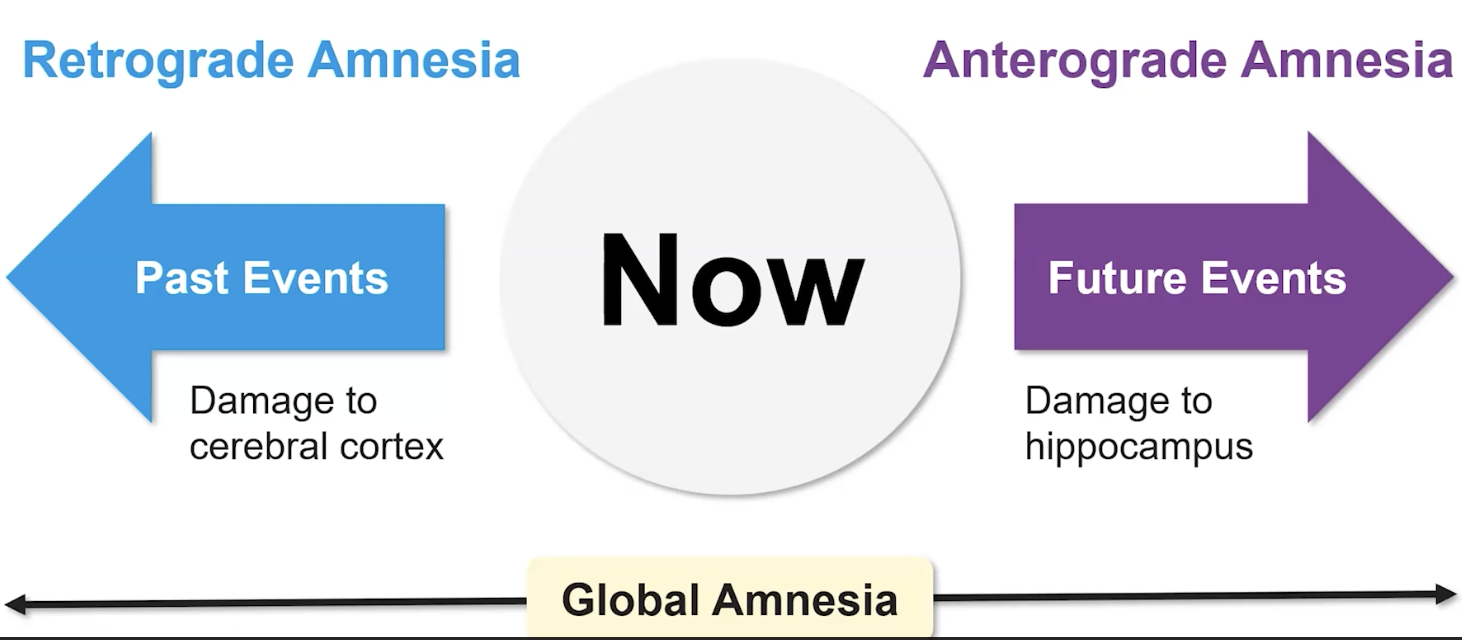
Hippocampi & Explicit Memory
Hippocampi: we have two, one in each hemisphere
In charge of explicit memory
Possible neurogenesis
Sloppy librarian analogy
librarians don’t know all the knowledge
they place the knowledge all over the library (cerebral cortex)
but not the whole book→when give memory back it’s a mishmash of pages
assemble memories through associated themes/schema
Witness stand analogy
conscious mind only hears what it thinks is the finished product/right information
biases: experiences and emotions that influence how your mind remembers things
Cognitive Biases
Confirmation bias
we don’t want what really happened from our memory
we want the memory that will support what we are thinking now
Hindsight bias
our current cognitive & emotional needs will go back in time & rewrite a memory
Overconfidence
our mind is convinced that what it produces is correct
Recognition vs. Recall
Recognition
Like a multiple-choice question
The other questions sometimes give you clues/something to recognize
Sometimes the clues can introduce a bias
Recall
Like a free-response question
Write down everything you know, much more difficult
Less susceptible to factors that would influence the accuracy of memories
Memory Retrieval Factors
Mood Congruent
our emotions often influence which memory is retrieved
Context-Dependent
The setting (clues such as sights & smells) help retrieval
State-Dependent
The memory pathways are only active in the right state
Retrieving Information
cognitive skill
can be trained & improved with practice
no one can retrieve information that wasn’t encoded
encoding is what happens during studying
Distributed vs. Massed Practice
Strategies to help with retrieval
Retrieval Practice
Neurons that fire together wire together
Long-term potentiation
Asking yourself what you learned & trying to retrieve it will make it easier to retrieve next time
Testing Effect
The more often you take a test or work with certain types of questions the better you become
You might not actually retrieve correct content, but the skill of taking a test can help
Also, the skill of answering certain types of questions can help retrieve the content
Metacognition
Thinking about your own thinking
Noticing what might be blocking information from appearing
Noticing what happens before the “a-ha moment”
Incubation
Sometimes when you want an answer or a solution, it is best to give your mind enough time to find the answer when it’s ready
Forgetting
Evolutionary
adaptation: forget info that will not increase survival
Biological
neural pathways rearrange/disconnect from old connections as the brain learns new things & changes (plasticity)
Psychodynamic
one part of our mind trying to protect other parts from info that’s upsetting (repression)
Social
we forget because we are not in the right social situation to retrieve (context dependent retrieval)
Cognitive
our mental indexing system has become disorganized, contents smudged/mixed together (proactive & retroactive and memory confabulation)
Humanistic
All people can and want to remember. No one has a bad memory, there are just barriers to a person using their memory to the fullest potential.
Behavioral
We forget because the association between stimuli (ex: sound of child’s toy & reflexive release of dopamine) has been disconnected.
Types of Amnesia
Infantile Amnesia
we can’t remember much before age 5
Psychogenic Amnesia
memory problem without physical cause or trauma (from mind)
Source Amnesia
difficulty remembering where you learned something
Anterograde Amnesia
difficulty encoding/inability to encode new memories (hippocampus)
Retrograde Amnesia
event that just happened blocks/prevents retrieval of old memories
ex: trauma to head
Amnesia vs. Interference
Amnesia: associated with storing & retrieving info
can/can’t you remember
Interference: associated with processing info
is what you’re currently thinking of corrupted by info processed at a different time
Retroactive Interference
new info corrupts, intertwines with/blocks info processed at an earlier time
self-consistency bias
Proactive interference
old info prevents, corrupts, or intertwines with current/recent info
“can’t teach an old dog new tricks”
Memory Reconstruction
Frontal lobe asks hippocampi to remember something
Hippocampi doesn’t retrieve what they encoded based on a precise process (not an algorithm)
They rebuild or reconstruct it based on what they think it should be (heuristics) “wings it” each time
Reconstructive memory, related to memory confabulation, (our mind blends inaccurate perceptions & images from several experiences & gives it to us as what it believes is a true record of what happened.)
Field Experiment
cross btwn. naturalistic observation and a laboratory experiment
reduces Hawthorne effect (act strangely due to feeling of being observed)
reduces demand characteristic (cues of a study revealing its true purpose to participants, influencing response)
you could not tell them exactly what the study is about (single blind)
if you deceive a subject you must offer debriefing
Eyewitness Testimony
can’t trust eyewitness testimony’s reconstruction & confabulation to be accurate
can’t trust your own either
False Memories
can be implanted because of the concepts of memory reconstruction & confabulation
Binet-Simon Test
test of where a “normal” child’s abilities “should be” at
became first test to classify mental abilities
Lewis Terman (don’t need to remember name)
Revised system of comparing mental age & chronological age so that the “average” intelligence would always be 100.
Mental Age: the average level at which the child should be operating at their age
Chronological age: compare with actual age of the child)
Two Factor Theory
we actually do have one general intelligence level
g for general mental ability
standard across all types of intellectual domains
however, we also might have specific mental abilities that fall outside of g→s
factor analysis
factors that are similar occur together and can be grouped into one thing
Multiple Intelligences vs. Two kinds of G
Multiple Intelligences
not how smart you are but how are you smart
Intelligence is based on unrelated domains
different than g, could be smart in one area and dumb in the other
like physical traits, has lots of factors that can exist independently of one another
Two Kinds of G:
Fluid Intelligence (Gf)
speed, youth, processing power, lack of knowledge
flexible and fast way to process information
Crystallized intelligence (Gc)
slower, can use experience to compensate/find short cuts in problem solving
Triarchic theory of intelligence
intelligence isn’t determined by a test but by how a person interacts with their environment
Triarchic theory (3 most important parts of intelligence)
Practical: how well can a person function in their environment? Realistic
Creative: how well can a person handle new situations? Experiential
Analytical: how well can a person find the answer? Academics
General mental ability (g-factor/general intelligence)
reflects a person’s ability to learn and adapt to new situations
the higher the g the better a person does in different challenges
Reciprocal determinism
a persons behavior affects their environment, and their environment effects them=loop
One General Intelligence vs. Multiple Intelligences Theory
One General Intelligence
high-g=do better
talent is inherent. it allows for quicker acquisition of knowledge and skills
Multiple Intelligences
s for special intelligence, an ability that is unrelated to other abilities
performance and ability are domain specific
It takes acquired skills and knowledge to demonstrate talent
How to measure intelligence/success in cultures
Individualistic Cultures“western”
values freedom, competition & individuality
success is making it on your own
intelligence is based on individual achievement
Collectivistic Cultures “eastern”
values cooperation, connection & harmony
success is improving the group
intelligence is based on how well you can work with others (group cohesion)
Operational definition
taking an abstract concept and assigning a number/definition to it
Hypothesis
If independent variable, then dependent variable
A hypothesis is easier to test if it is numerically measurable
Types of variables in an experiment
Independent variable: what the researcher or participant does
Dependent variable: what the researcher or participant gets (result)
Confounding variable: anything that affects the dependent variable that is not the independent variable (culture, beliefs about one self)
Construct Validity
the culture of the test-maker & test-taker can affect how the test is taken/made
Confirmation bias
tendency to search for, interpret, favor and recall information in a way that confirms or supports one’s prior beliefs or values
Structured Interview
allows for the classification of an experience or concept without trying to reduce it to a number (qualitative research)
most scientific research methods are quantitative but converting certain things to numbers introduces confounding variables
Stereotype Threat vs. Stereotype Lift
Stereotype threat
unconscious process of one’s performance being reduced to match what society believes
members of a group who think of their group membership before a task may unconsciously conform negatively to what society thinks of their group
stereotype threat is a confounding variable for cognitive tests
we control this confounding variable by using the single blind technique (won’t tell the people taking the test what its about so they don’t have biases)
Stereotype Lift
unconscious process of one’s performance being improved to match what society believes
members of a group who think of their group membership before a task may unconsciously conform positively to what society thinks of their group
still confounding variable
Central Tendency
leaning toward the middle
Mean: numeric average found by dividing the sum by the number of scores
the only measure of central tendency that is greatly affected by extreme scores or outliers
Median: the middle score in an array of scores in order
Mode: the score that appears most often in a set of scores
Bell Curves
Diagram
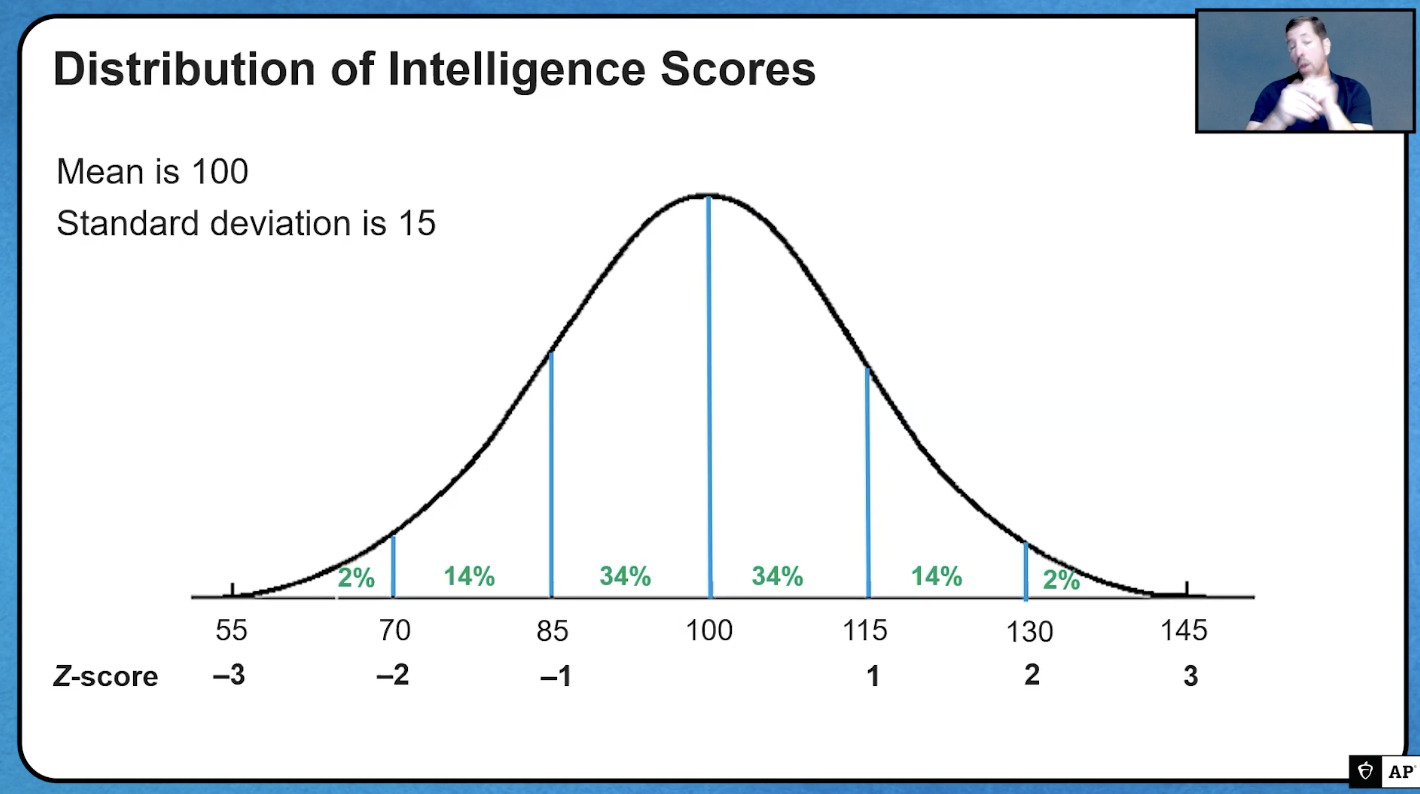
Skews
Positive skew
outliers to the right pull it to the right/drag
mean pulled to the right
Symmetrical Distribution
mean median & mode are the same
Negative skew
tail of bell curve pulled to left
outliers to the left
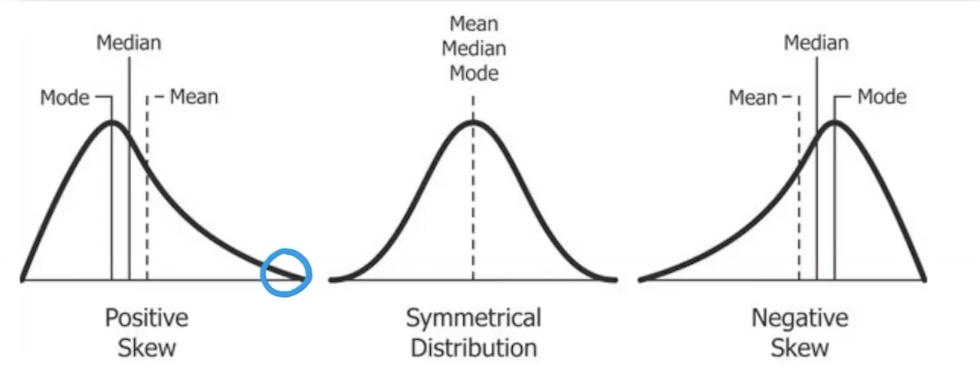
Standard Deviation
a number that tells how much the scores in a set differ from the mean
Intelligence Tests needed traits
Standardization
Against what is an individual score compared? Their age? Other scores?
Reliability
Is the score stable over time if all other variables remain the same?
Validity
Does the test actually measure what it says it measures
4 types of validity
Types of validity
Content validity: the extent to which a test measures the intended content/covers all important parts of the content
ex: only covering one unit on the test would be low content validity
Construct validity: whether a test truly measures the theoretical concept it claims to measure
similar to operationalization. how can an abstract idea be translated into something that can be measured?
Criterion validity:
does it correlate to an outside measure?
ex: if a test score says someone’s a genius but they repeatedly use a fork to drink soup they have low criterion validity
Predictive validity:
how well a test predicts future performance
only works for large sets of data and can only predict a trend
standardized tests do not have predictive validity for individuals
Types of Tests
Achievement: measures how much you learned in the unit
AP
Predictive: measure what will happen based on data collected
SAT
Aptitude: attempts to measure a person’s ability. Ability is not stable or static.
Jean Piaget’s idea of children being measured individually
Lev Vygotsky’s ideas that ability is context & socially dependent
Epigenetics
long term environmental pressure changes our genetic expression (not genes themselves)